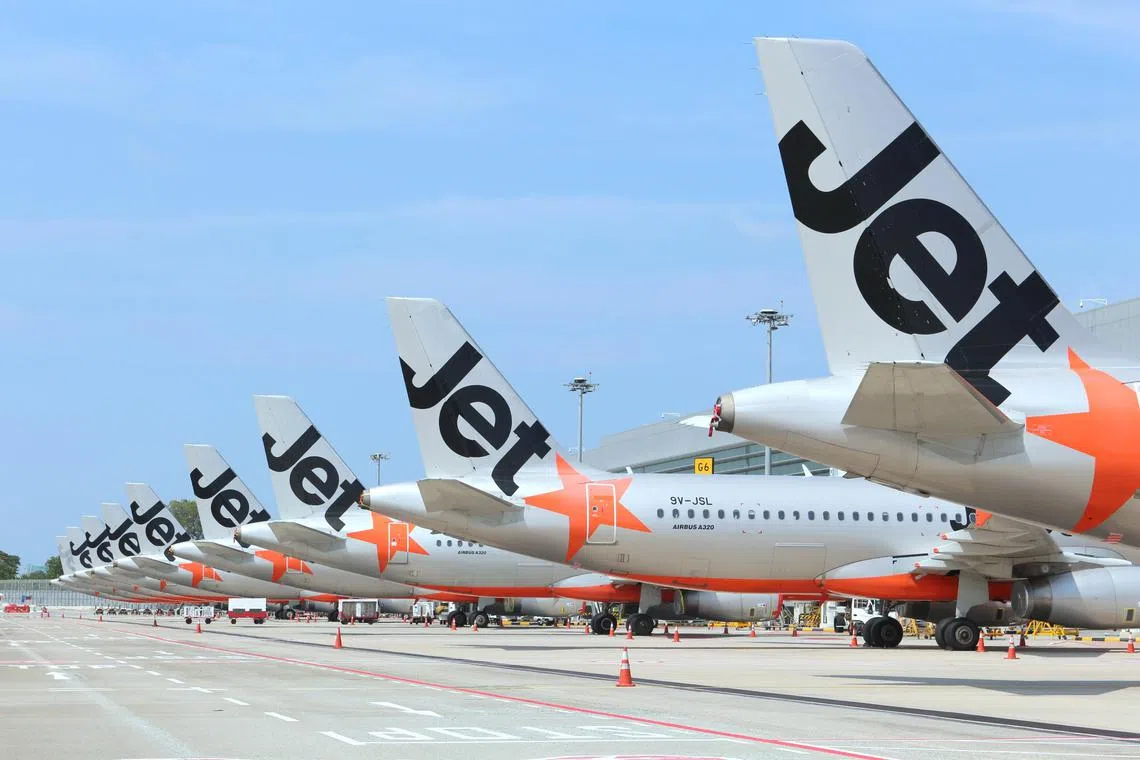Jetstar Asia intent on offering more unique destinations at low fares from Singapore
Sign up now: Get ST's newsletters delivered to your inbox

Singapore-based Jetstar Asia has accounted for more than 10 per cent of Jetstar Group’s total revenue in the past 15 years.
PHOTO: JETSTAR ASIA
Follow topic:
As it gets ready to celebrate its 20th year in Singapore, Jetstar Asia intends to enhance its niche as a low-cost carrier (LCC) offering flights to unique regional destinations at low fares out of Changi Airport.
This is an assurance that the carrier’s chief executive John Simeone
“We had 18 planes prior to the pandemic, but we now have 11 planes serving 17 destinations in eight countries,” said Mr Simeone, who took over as CEO of Jetstar Asia in early 2024.
“Ideally, we would ultimately like to go back to 18 planes, but, for now, we have the right size to create an adequate return on investment.”
The airline, which is 49 per cent owned by Qantas and 51 per cent by Singaporean company Westbrook Investments, plans to increase its fleet to 13 planes by the end of 2024.
Jetstar Asia operates under the umbrella of Jetstar Group, the low-cost subsidiary of Qantas. The Melbourne-based LCC chalked up A$4.9 billion (S$4.3 billion) in revenue in 2023, just over 20 per cent of parent Qantas group’s A$21.9 billion revenue.
Singapore-based Jetstar Asia has accounted for more than 10 per cent of Jetstar Group’s total revenue in the past 15 years.
With the pandemic now behind it, Jetstar Asia has been steadily broadening its regional network over the past year and currently operates 320 flights a week.
In addition to new routes such as to Haikou and Broome, it will soon start flights to new destinations like Colombo and Medan.
While seeing robust demand on services to large cities like Kuala Lumpur, Bangkok and Jakarta, the airline also fills its cabins to numerous holiday destinations such as Okinawa, Krabi and Wuxi.
“We will continue to think about unique destinations out of Changi,” said Mr Simeone, who was previously Qantas’ senior vice-president for Asia, where he was responsible for its operations stretching from India to Japan.
“We have sold about two million tickets since early 2023, and two-thirds of them were under $100.”
Consistently ranked among the top LCCs in Asia for both safety and timeliness, Jetstar Asia employs about 500 people in Singapore, 70 per cent of whom are Singaporeans. It was recently ranked among the “Best Low-Cost Airlines in Asia 2024” by Skytrax and rated one of the top five airlines by passenger carriage at the Changi Airline Awards 2024.
As the carrier prepares to celebrate its 20th anniversary in December, besides commemorative events and possible ticket offers, it will also unveil brand-new uniforms for its cabin crew, Mr Simeone revealed. The old uniforms will be recycled into “something unique and useful”, he said.

Jetstar Asia CEO John Simeone, who was previously Qantas’ senior vice-president for Asia, says the low-cost carrier “will continue to think about unique destinations out of Changi”.
PHOTO: JETSTAR ASIA
Asked about how the airline’s highly publicised move to Terminal 4 (T4) in Changi in 2023 had impacted its interline arrangements, especially with parent Qantas, which remains in Terminal 1, Mr Simeone said the transition has worked out seamlessly.
“Passengers can transfer between Terminal 1 and Terminal 4 within 15 minutes using airside buses. Those who have more time between connections can come through immigration and spend a few hours outside, then take the landside buses to their connecting flight, which also takes about 15 minutes.”
Besides Qantas, Jetstar Asia’s other code-share partners include Emirates, Finnair, Air France-KLM and Sri Lankan Airlines, as well as more than 40 interline partners.
Despite some well-publicised and sometimes heated exchanges leading up to the move, Mr Simeone complimented Changi Airport Group for making the T4 transition seamless and painless.
But one issue that LCCs like Jetstar Asia will continue to grapple with is the cost of operating out of one of the most expensive airports in the region. Changi’s airport charges and fees are known to be relatively higher than at regional peers.
Mr Simeone noted that cost was a given for all carriers operating out of Singapore.
“Cost is something we always have to deal with on a daily basis. Also, LCCs will always find it exceptionally difficult to pass down costs to customers as doing so would raise airfares,” he said.
While upbeat on the outlook for air travel around the region, Mr Simeone acknowledged that travel demand would be subject to various other factors such as the geopolitical situation, economic outlook and unforeseen events, as was the case during the Covid-19 pandemic. Industry experts believe airlines could also be challenged by costs related to the sustainability transition.
The Qantas group has already started on this journey, committing itself to achieving net-zero carbon emissions by 2050.
But given the robust economic circumstances of the region and the sense of “wanderlust” among its relatively young population, Mr Simeone is upbeat on Jetstar Asia’s future.
“We want to try new and different things, and provide something unique to our customers,” he said.


